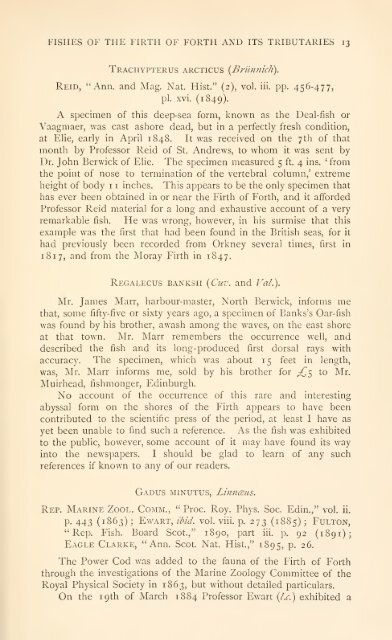Create successful ePaper yourself
Turn your PDF publications into a flip-book with our unique Google optimized e-Paper software.
FISHES OF THE FIRTH OF FORTH AND ITS TRIBUTARIES 13<br />
TRACHYPTERUS ARCTICUS (BrunnicK).<br />
REID, "Ann. and Mag. Nat. Hist." (2), vol. iii.<br />
pp. 456-477,<br />
pi. xvi. (1849).<br />
A specimen of this deep-sea form, known as the Deal-fish or<br />
Vaagmaer, was cast ashore dead, but in a perfectly fresh condition,<br />
at Elie, early in April 1848. It was received on the 7th of that<br />
month by Professor Reid of St. Andrews, to whom it was sent by<br />
Dr. John Berwick of Elie. The specimen measured 5 ft. 4 ins. ' from<br />
the point of nose to termination of the vertebral column,' extreme<br />
height of body 1 1 inches. This appears to be the only specimen that<br />
has ever been obtained in or near the Firth of Forth, and it afforded<br />
Professor Reid material for a long and exhaustive account of a very<br />
remarkable fish. He was wrong, however, in his surmise that this<br />
example was the first that had been found in the British seas, for it<br />
had previously been recorded from Orkney several times, first in<br />
1817, and from the Moray Firth in 1847.<br />
REGALECUS BANKSII (Cuv. and Val.}.<br />
Mr. James Marr, harbour-master, North Berwick, informs me<br />
that, some fifty-five or sixty years ago, a specimen of Banks's Oar-fish<br />
was found by his brother, awash among the waves, on the east shore<br />
at that town. Mr. Marr remembers the occurrence well, and<br />
described the fish and its<br />
long-produced first dorsal rays with<br />
accuracy. The specimen, which was about 15 feet in length,<br />
was, Mr. Marr informs me, sold by his brother for ,5 to Mr.<br />
Muirhead, fishmonger, Edinburgh.<br />
No account of the occurrence of this rare and interesting<br />
abyssal form on the shores of the Firth appears to have been<br />
contributed to the scientific press of the period, at least I have as<br />
yet been unable to find such a reference. As the fish was exhibited<br />
to the public, however, some account of it<br />
may have found its way<br />
into the newspapers. I should be glad to learn of any such<br />
references if known to any<br />
of our readers.<br />
GADUS MINUTUS, Linntzus.<br />
REP. MARINE ZOOL. COMM., " Proc. Roy. Phys. Soc. Edin.," vol. ii.<br />
p. 443 (1863); EWART, ibid. vol. viii. p. 273 (1885); FULTON,<br />
"Rep. Fish. Board Scot.," 1890, part<br />
iii.<br />
p. 92 (1891);<br />
EAGLE CLARKE, "Ann. Scot. Nat. Hist.," 1895, p. 26.<br />
The Power Cod was added to the fauna of the Firth of Forth<br />
through the investigations of the Marine Zoology Committee of the<br />
Royal Physical Society in 1863, but without detailed particulars.<br />
On the igth of March 1884 Professor Ewart (I.e.] exhibited a

















